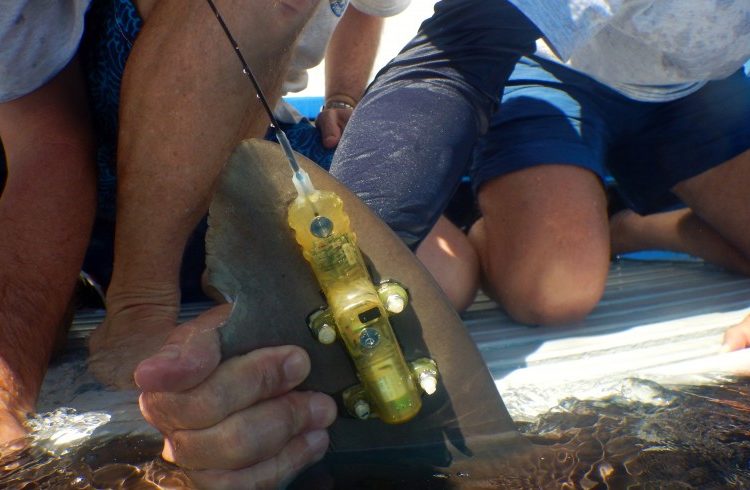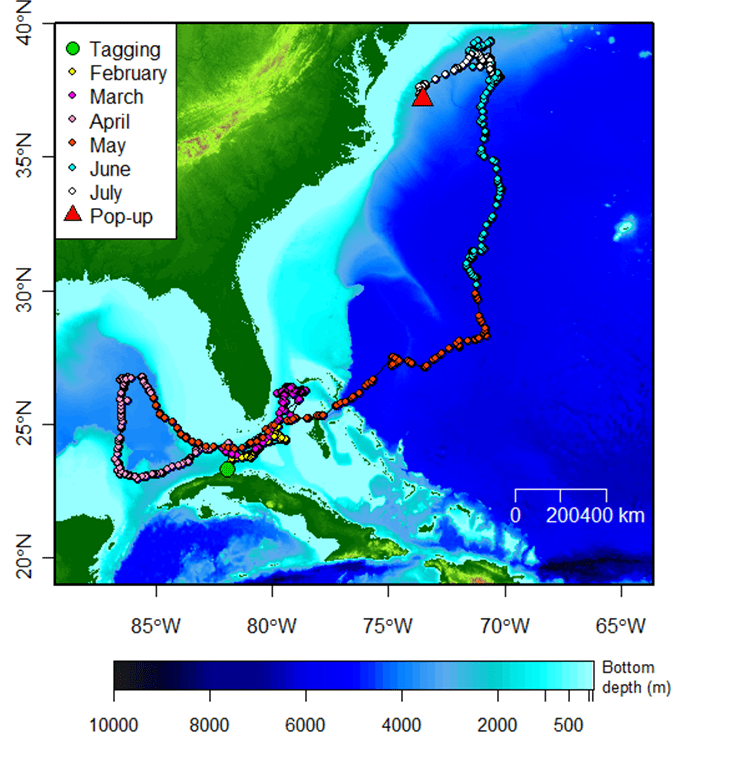On Cuba’s northern shore, Cojimar appears peaceful, cooled by the refreshing winds of an especially cold February. Known as the place where an enormous white shark was caught in 1945, the fishing town that inspired Hemingway’s The Old Man and the Sea is about to become news once again thanks to another large shark.
It’s the last day of an expedition that gathered Cuban and US scientists for the first time, under the watchful gaze of the cameras of Shark, a Discovery Channel series. Luck and experience have come together and a male, 8-foot-long, longfin mako shark is fitted with a PAT satellite tag, 18 miles east of Cojimar. It’s the second time scientists from MOTE Laboratories accomplish this feat, and this time they do so alongside Cuban researchers. Now, it’s time to celebrate and wait.
It’s been exactly 150 days since that last and encouraging day of July 15, 2015. In Cuba and the United States, researchers from MOTE Laboratories, the Environmental Defense Fund, the Coastal Ecosystems Research Center and other institutions involved in the expedition are about to receive the much-awaited news. According to Robert Hueter, director of the shark research department of MOTE, the satellite tag placed in the mako shark came up to the surface, exactly as predicted.
“The tag emerged some 125 miles east of the mouth of Chesapeake Bay, in US waters, along the continental slope,” explains the scientist, who waited nearly five years to realize his dream of fitting Cuban sharks with satellite tags.
The data transmitted over the following three weeks revealed that the shark left Cuba’s northern shore, traced a loop towards the eastern end of the Gulf of Mexico and then took a turn left to pass by the Bahamas and end up before the United States’ mid-Atlantic coast, near the shores of New Jersey.
“This is very interesting for us,” Hueter says, “because the only other mako that has been fitted with a satellite tag by MOTE scientists also swam to this location in mid-July. That was also an adult male of about the same size as the Cuban shark. So, it looks as though there’s something in this area that’s attracting mature males during the summer.”
Though the mako got all the media attention, other satellite tags were installed during the expedition south of Cuba. In the waters of the Jardines de la Reina protected area, where researchers also conducted experiments on coral reefs, the team managed to fit three silk sharks with the devices. No hooks, nets, ropes or spears were used. Cuban scuba-diver Noel Lopez Fernandez applied his own version of the tonic immobility technique. Fernandez softly presses each of the shark’s fins while swimming next to them until the animal relaxes and he can take it into his arms. Experts have baptized the technique as “fin and tonic” and suggest we do not try it at home.
The data received from the PAT satellite tags placed in the two silk sharks (the third tag is a real-time transmission device) also attests to the value of the scientists’ perseverance.
The information reveals that, contrary to what was previously thought, silk sharks don’t spend all of their time near Cuban coral reefs but swim in deep waters also, perhaps in other areas of the country. A month after being installed, the devices showed that the two sharks spent time at a depth of approximately 2,000 feet.
The findings, revealing the shark’s “multinational” swimming habits, is probably one of the expedition’s most important results. “The fact these sharks go back and forth between the waters of different countries,” Hueter eplains, “reveals how important it is to coordinate sustainable practices for our fishing resources and conservation efforts at the multi-national and global scales. Evidently, it is important for Cuba and the United States to work together with a view to protecting their vulnerable maritime resources, such as these rare species of sharks in danger of extinction,” he concludes.
According to date from MOTE Laboratories, the Gulf of Mexico and Caribbean (with Cuba at the epicenter) are home to 20 percent of the world’s shark biodiversity. Over the past 40 years, species populations have declined at a pace experts are calling “dramatic.” Contrary to what may be held by those stuck with the terrifying images of Jaws, this is not good news. Sharks are essential to the balance of maritime life and a rise in shark populations would have a positive impact on fishing in the region.
Politicians on both shores of the Strait of Florida appear to agree with scientists as regards the need to protect maritime resources. During the long negotiations process that led to the re-establishment of diplomatic relations between Cuba and the United States, the issue has been brought up as a topic of “common interest.”
In January this year, a communiqué issued by the Cuban delegation that took part in the bilateral talks declared that our “authorities are willing to hold exchanges with their US counterparts on the issues of seismic monitoring, protected maritime areas and hydrography, as well as participate in joint research work on marine species.”
During his address for the re-opening of the US Embassy in Havana, Secretary of State John Kerry mentioned the areas where the two countries should work together “as neighbors”: the protection of the marine environment and climate change.
According to Hueter, in addition to shark research, the study of coral reefs, sustainable fishing and maritime mammals could build bridges between the two countries, “in a way that goes beyond political differences.”
Though MOTE researchers have been traveling to Cuba with the support of the Environmental Defense Fund for more than 10 years and establishing contacts with Cuban institutions, this new context can mean, for instance, that Hueter and his team do not have to wait another five years to again realize the dreams he shares with his Cuban colleagues.
Scientists in both countries are helping fill gaps in our knowledge about shark populations in the Caribbean and the Gulf of Mexico. These are small but essential steps. Swimming from Havana to New Jersey, a mako shark has unwittingly opened up new avenues of scientific research and understanding.
https://www.youtube.com/watch?v=uTl8Vtn8yk4











